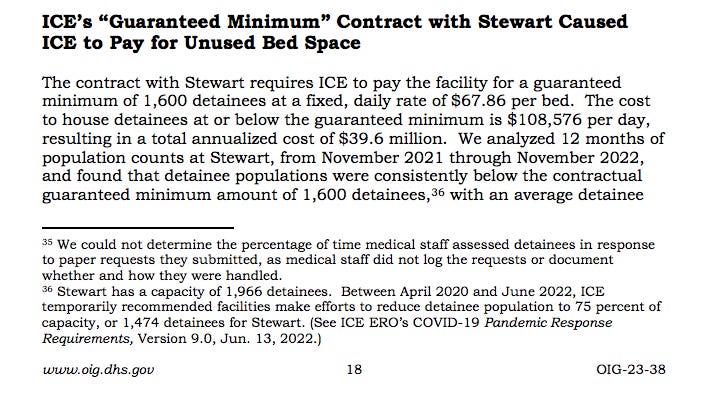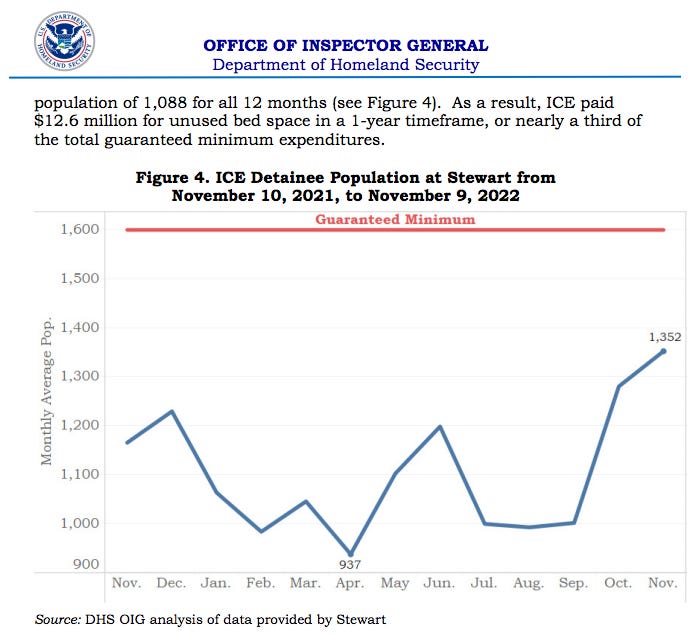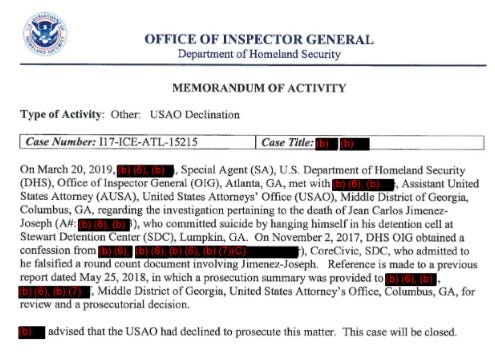Stewart's 8-Year Death Spiral
A single facility holding less than 5% of ICE's population accounts for nearly 15% of the 85 deaths in ICE custody since 2017. What will it take to finally shut it down?
Wishing a very happy #FOIAFriday to our growing ranks of subscribers and readers! As always, I really appreciate your time, compassion, feedback, and support. Thanks for making this work possible!
As I reported last week, another human ended their life inside Georgia’s Stewart Detention Center on June 7. Jesus Molina-Veya became the 14th person to die after being designated for detention at Stewart by ICE since it opened in 2006, according to publicly available information.
Today, I offer an evidence-based analysis of Stewart’s past and present, and a modest recommendation for its future, all based on FOIA, public-source reporting, and data analysis.
TL:DR - Stewart is on its way to collapse, and it’s up to us to keep pushing in that direction.
A Staggering Statistic
14.3% of all deaths in ICE custody since January 1, 2017 involved people sent by ICE for detention at CoreCivic’s Stewart Detention Center in Lumpkin, Georgia. (CoreCivic accounted for 33% of all ICE deaths during the same period—significantly higher than GEO, which had a comparable number of beds).
Figure 1: Deaths in ICE Custody by Primarily Associated Facility since 2017. (Link)
12 of the 85 adults who passed away in the agency’s custody during this roughly 8-year period were either bound for, locked inside, or rushed to the hospital after detention at Stewart.
Figure 2: Deaths in Custody involving Stewart Detention Center. Source: Public-Source ICE Deaths Tracker Available Here.
Putting Stewart’s outsized role in death-making into context, the facility’s 1,920 available, contracted beds account for — at maximum — less than 5% of ICE’s funded detention capacity at a funding level of 41,000. When we take into account the actual average daily population for Stewart and the larger ICE system (something Austin Kocher might be able to do with longitudinal data), Stewart accounts for even less of the ICE system as a whole.
This means Stewart contributes three times as many deaths to ICE’s detention system as it would if deaths were evenly distributed. So, people imprisoned for ICE at Stewart are 300% more likely to die than they would be if detained elsewhere.
Stewart is the deadliest detention facility by far since 2017, nearly doubling its next closest rivals, Miami’s Krome (7 deaths) and Rio Grande Valley’s Port Isabel (6 deaths).
Stewart’s Undeniable Lethality
As a 2020 report from the then-majority staff of the House Government Oversight Committee revealed, ICE has repeatedly concluded CoreCivic’s operation of Stewart, and the Atlanta ERO Field Office’s inadequate supervision of those operations, contributed to people’s deaths there. ICE’s contracting officials levied a tiny penalty against CoreCivic—a mere 20-40% reduction on a single month’s invoice for the deaths of Jean Jimenez and Efrain Romero de la Rosa in 2017 and 2018, respectively.
Source: ICE Contract Discrepancy Report.
Watch Efrain’s story here.
These fatal failures cost the company less than 3% of the roughly $39.6 million DHS-OIG says its contract entitled it to receive from ICE.
Source: DHS-OIG Report 23-38, Results of an Unannounced Inspection of Stewart Detention Center (July 2023).
After ICE showed CoreCivic how cheap it is to end a person’s life through failing to fulfill its contract obligations (most notably, understaffing that helps make the fixed-rate contract even more profitable), 9 more people have died in or on the way to Stewart. This is impunity through efficient breach.
The impunity does not stop with ICE. The U.S. Department of Justice similarly demonstrated to ICE ERO ATL and CoreCivic that conduct by Stewart staff DHS-OIG finds criminal and warrants referral for prosecution will not actually be prosecuted. Inspector General investigators twice concluded that CoreCivic guards’ falsification of logs and untruths post-death warranted referral to the U.S. Attorney’s Office for the Middle District of Georgia. In the case of Jean Jimenez, who died by suicide May 15, 2017, that office rejected prosecution, though it has never supplied its declination memo despite multiple FOIA requests and ongoing litigation.
Source: Chaverra v. ICE (D.D.C.) FOIA release from DHS-OIG.
Two months after the US Attorney’s Office declined prosecution, Efrain Romero died a nearly identical death. Once again, DHS found CoreCivic’s guard falsified records to claim visual checks were performed when they were not. Again, no consequences followed for CoreCivic aside from its 20% monthly invoice penalty. That quarter (Q3 2018), CoreCivic reported $422.3 million in revenues. A 20% penalty would have amounted to less than a million dollars. A rounding error on the balance sheet.
Where business incentives were inadequate to curtail cost-cutting measures that fueled mortality and morbidity, deaths continued to rise.
A June 2024 report from the ACLU, Physicians for Human Rights, and American Oversight found that Stewart led the pack in preventable in-custody deaths in ICE custody.
Source: Deadly Failures: Preventable Deaths in U.S. Immigration Detention (Jun. 2024)
Months earlier, the now-emptied DHS Office for Civil Rights and Civil Liberties (CRCL) opened another investigation into Stewart, the focus of which included a 2023 death in custody where ICE’s Office of Professional Responsibility once again found multiple violations the Performance-Based National Detention Standards. The fate of this investigation is unclear.
Prior CRCL investigations and outside expert reviews obtained through FOIA litigation prove definitively what DHS, ICE, CRCL, and CoreCivic have known since 2017: Stewart is incredibly dangerous and deadly because of its failures to abide by federal standards and the corresponding failure of ICE to punish the company meaningfully when its failures create the conditions that lead to death. And when this happened, the company and its supervisors in the ICE Atlanta Field Office didn’t even bother to provide complete enough responses to allow expert reviewers hired by CRCL to assess whether they’d complied with ICE’s own Corrective Action Plan.
Everyone Knows, No One Acts
In 2021, on the heels of cutting ICE’s contract with LaSalle Corrections to imprison people in the Irwin County Detention Center, DHS Secretary Alejandro Mayorkas committed on camera to reviewing conditions at Stewart for possible closure. One of his predecessors, former DHS Secretary Janet Napolitano told the reporter who got that on-camera commitment that if the numbers were true—if Stewart was as clear an outlier as it appeared—it should be closed, and Ale Mayorkas should be the one to close it.
He didn’t.
Instead, national news broke about sexual assault and harassment of detained immigrant women by a male nurse at Stewart. The allegations impacted some of the very same immigrant women who’d have been detained at Irwin but for the Senate-substantiated allegations of nonconsensual and medically unnecessary gynecological procedures, including potentially sterilizing surgeries. (More on that here.) As with the Irwin gynecologist, no prosecutions followed, no federal debarments, no permanent sanctions.
Unlike Irwin, ICE kept putting people inside Stewart. Lots of people.
So at least three more people died, bringing the current number to 12 since 2017.
The Federal Government Believes Stewart is Too Big To Fail
Impunity takes constant reinforcement. It takes ignoring the steady stream of very real and concrete harms to human beings that occur when you choose profit and prisons over humanity and healing. The only rational conclusion at this point, given Stewart’s unbroken record of operation and funding by DHS despite—or because of—its deadly record is that this is exactly the way ICE, DHS, Congress, the President, the courts, and the market want it.
It would be too disruptive to ICE’s detention system to lose a 2,000+-bed hub, or worse yet, one of the largest two detention contractors, they’ve concluded, to end this contract over the loss of one or two or three or twelve human lives. Resign the wardens, fire the guards, promote or retire the field office staff, levy the contract penalties and carry on.
This is the deadly status quo.
How long can it endure, and at what price? Pretty long, as it turns out, if we’re looking to the prison and jail space for precedent. Under this logic, eventually, probably sooner rather than later, Stewart will be just one of the many places ICE knowingly sends vulnerable people to die, or face increased risk of death. Historians have a phrase for that. If we use it in the present, in public, we’re not historically literate, but “hysterical” and “hyperbolic.” Death camps didn’t start explicitly as death camps, either, though.
The Least Hopeless Place in the System
Despite the data, I do not lack for hope. I know Stewart will close one day. It’s been operating as an ICE detention center for only slightly longer than we’ve had iPhones. It is not at all inevitable that it continues to exist. It’s just meant to seem that way.
The folks inside, folks like El Refugio who help support their efforts to connect and fight their way out, and a vast and growing community of people are aware of what’s happening there. They’re hearing more stories from inside more frequently, and the public has had enough. That energy builds and accretes to a breaking point—one where the right spark is all it takes to completely alter the status quo and remake the reality of the world. What will it be? I don’t know. No one does. That’s why we continue to research, make records requests, organize, keep in touch with folks inside, and think strategically and dream boldly. Not just about a world where a single facility doesn’t account for nearly 15% of the deaths in custody; but about a world where no one dies in ICE custody because ICE does not exist.
Stewart is a breaking point. It is a beacon. It is incumbent upon those of us with the privilege to act to do so. I really loved this piece from 285 South about what that can look like, and highly encourage folks to check it out.
Death at Stewart is not an end but a beginning. Peer deeply into the deaths that occur there, and a more survivable, hopeful, fulfilling life stares back.











